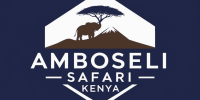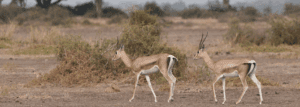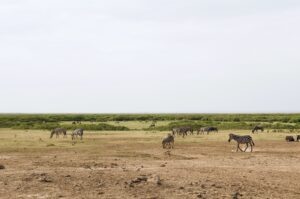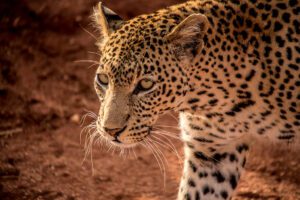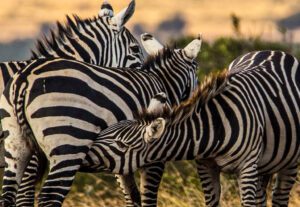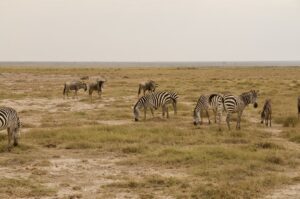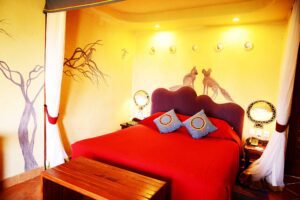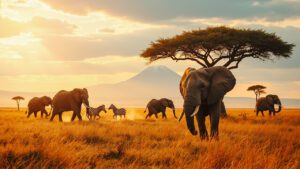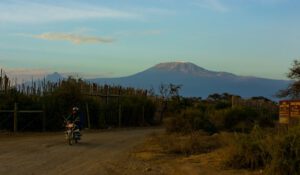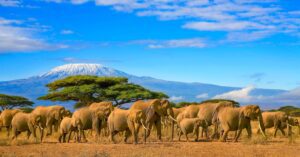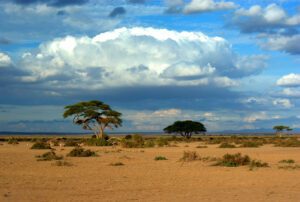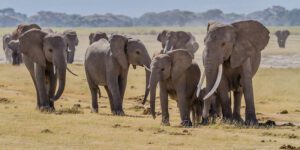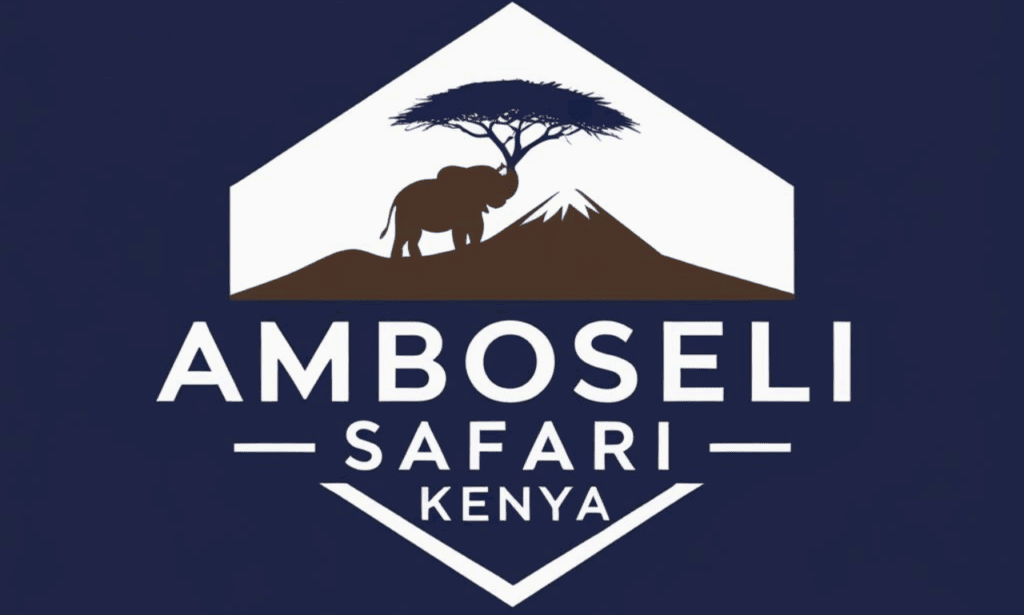What is an Amboseli photography safari, and what makes it unique?
An Amboseli photo safari is a specialized trip to Amboseli National Park in Kenya, designed specifically for photographers who want to capture incredible images of wildlife, landscapes, and local culture. This park is famous for its breathtaking scenery and iconic wildlife, making it one of the most sought-after destinations for Africa wildlife photography tours. What makes it particularly unique is the park’s dramatic backdrop, which features Mount Kilimanjaro, the tallest mountain in Africa. The snow-capped peak of Kilimanjaro rising above the savanna creates stunning and unforgettable photographs, especially during sunrise or sunset.
The park is also known for its large herds of elephants, some of the largest in Africa. These elephants are incredibly photogenic, often walking in groups with Mount Kilimanjaro in the background, providing an ideal subject for photographers. The elephants in Amboseli are habituated to vehicles, making it easier to get close-up shots compared to other areas where animals might be more skittish, which is a significant advantage for those on a Kenya photo safari.
Another unique feature of Amboseli is its varied landscape, which includes open plains, swampy wetlands, acacia woodlands, and dry lake beds. This diversity not only allows for a variety of photographic scenes but also attracts an array of wildlife that thrives in these different environments.
In summary, an Amboseli photography safari is a dream journey for photographers because it combines stunning landscapes, iconic wildlife, and dramatic natural lighting. The park’s unique blend of easy access to animals, diversity of habitats, and the incredible Mount Kilimanjaro backdrop make it a must-visit destination for anyone passionate about photography.
What kind of wildlife and scenery can I expect to photograph in Amboseli?
In Amboseli National Park, you can expect to photograph some of the most extraordinary wildlife and landscapes in Africa. The park is home to a wide variety of iconic animals, making it a paradise for wildlife photography. The “stars” of Amboseli are undoubtedly the African elephants, a large population roams the park, and these elephants are particularly famous for their majestic size and ease of photographing. You’ll likely encounter them walking in family groups, interacting with each other, or bathing in the swamps during your Amboseli photo safari.
Beyond elephants, other popular animals you can capture include lions, cheetahs, hyenas, giraffes, zebras, wildebeests, and buffalo. The swamps and wetlands of Amboseli attract hippos and crocodiles, while bird enthusiasts will find plenty of species to photograph as well, such as flamingos, herons, pelicans, and eagles, making it a prime location for an Africa wildlife photography tour.
The scenery in Amboseli is equally stunning. Mount Kilimanjaro serves as the ultimate backdrop for much of your photography, particularly during clear mornings or evenings. The image of wildlife crossing the open savanna with the mountain in the distance is one of the most iconic shots for any photographer on a Kenya photo safari. The park also features contrasting landscapes, such as the dry, cracked earth of the lake beds (Lake Amboseli dries up seasonally) and the lush greenery around the swamps.
Golden hour photography is particularly magical here as the soft light illuminates the animals and landscapes, creating a warm and dramatic look. You’ll also find striking contrasts between the colorful wildlife, such as pink flamingos in the water, and the dry, dusty environment, enhancing your photographic safaris experience.
Simply put, Amboseli offers photographers the chance to capture quintessential African wildlife and landscapes in a concentrated, scenic area, making it a must-visit for any passionate wildlife photographer.
What is the best time of year to go on a photography safari in Amboseli?
The best time to go on a Kenya photo safari in Amboseli depends on what you want to photograph, but generally, the dry season from June to October is considered the ideal period. During this time, the weather is sunny and clear, which increases your chances of getting clear views of Mount Kilimanjaro in the background. The drier conditions also mean that animals are more concentrated around the water sources, such as the swamps and wetlands, making it easier to spot and photograph a variety of wildlife in one area, including elephants and giraffes.
July to September is especially great because it’s cooler and animals like elephants tend to be more active. You can often capture photos of them wading through the water or walking in their herds across the dry plains. Early mornings and late afternoons during this period provide the best lighting for photography, as the golden hues of sunrise and sunset create dramatic, warm-toned images, perfect for an Africa wildlife photography safari.
If you’re a fan of migratory birds, visiting between November and April aligns with the wet season, when birdlife in Amboseli is at its peak. You’ll see flamingos, pelicans, and other migratory species that come to the park in search of food and breeding spots. However, the rainy season can also make some areas harder to access, and skies might be overcast, so this may not be ideal for all photographers.
In short, if clear skies, abundant wildlife, and perfect natural lighting are your priorities, plan for a visit in the dry season (June–October). But if you want to photograph birds and don’t mind occasional rains, the wet season (November–April) has its own charm. Both seasons guarantee incredible photography opportunities in unique ways.
What photography gear should I bring for an Amboseli safari?
When going on an Amboseli photo safari, having the right gear is essential to capture the incredible landscapes, wildlife, and uniquely beautiful moments the experience offers. Amboseli National Park, located in Kenya, is famous for its stunning views of Mount Kilimanjaro, large elephant herds, and diverse wildlife. Here’s what you’ll need in terms of photography gear:
First, bring a good DSLR or mirrorless camera. These cameras are versatile, produce high-quality images, and work well in various lighting conditions. A crop-sensor camera is also fine but may have limitations with wide angles for landscapes.
Lenses are critical. A telephoto lens, like a 200mm to 600mm, is ideal for photographing animals that are farther away, like lions, giraffes, or even birds in flight. For large animals like elephants, which roam close to the safari vehicles, a lens in the 100-400mm range works wonderfully. Don’t forget a wide-angle lens (like 16-35mm or 24-70mm) to capture expansive landscapes or iconic shots of Mount Kilimanjaro.
Since safaris often happen during the golden hours , sunrise and sunset , lighting can vary dramatically. Pack a polarizing filter to minimize glare in bright midday conditions and help bring out vibrant skies. A sturdy tripod or bean bag is also helpful for stabilizing your camera, especially since safari vehicles sometimes bounce on uneven roads.
Ensure you carry plenty of memory cards and at least two camera batteries (or more). You don’t want to run out of storage or charge just as you come across something amazing, like elephants walking against a stunning Kilimanjaro backdrop. A power bank or portable charger is wise because charging options can be limited in the middle of the wilderness.
Lastly, don’t forget protective gear for your equipment. Amboseli’s safari trails are dusty, so carry a camera bag or backpack with rain covers and extra lens cloths to clean your gear. A UV filter can add extra protection to your lenses.
By preparing this gear, you’ll be ready for the adventure, whether you’re photographing a majestic lion, the golden plains, or the dramatic cloud formations over Mount Kilimanjaro, making your Africa wildlife photography safari unforgettable.
Are there specific techniques or skills needed for wildlife and landscape photography in Amboseli?
Yes, both wildlife and landscape photography in Amboseli require certain techniques and skills to truly capture the magic of this region. Let’s break it down into wildlife photography and landscape photography:
For wildlife photography, patience is perhaps the most important skill. Animals move naturally in their environment, and you can’t control them. Staying calm and waiting for the right moment is key. Practice shooting in burst mode (continuous shooting) to capture split-second movements clearly, whether it’s a cheetah on the hunt or an elephant spraying water.
Another skill is understanding your camera settings, particularly shutter speed, aperture, and ISO. Use a fast shutter speed (1/1000 or higher) to freeze motion, such as a bird in flight or galloping zebras. Aperture settings will depend on the scene , use a shallow depth of field (lower f-number like f/4) to make an animal stand out from its background, or a higher f-number (f/11 or above) for group shots or landscapes.
Amboseli’s landscapes are breathtaking, so mastering landscape photography techniques is equally important. The golden hours of dawn and dusk are the best times for soft, warm, and dramatic lighting. Use a tripod and a smaller aperture (f/11-f/16) for wide depth of field, so everything from the mountains to the savannas is in focus.
Don’t ignore composition. Use the “rule of thirds” , place key subjects (like elephants, Mount Kilimanjaro, or acacia trees) in one-third of your image for balanced and natural-looking photos. For wildlife and landscapes, always consider the symmetry and leading lines to draw a viewer’s eye across your photo.
Finally, practice and adapt to weather and light conditions in Amboseli. The skies can go from sunny to stormy quickly, so adjust your settings, such as increasing ISO or using filters, as you go. These tricks will help you take stunning, professional-looking shots.
How close can I get to animals, and is it safe to photograph them?
On an Amboseli photo safari, animals roam freely in their natural habitat, and it’s common to get relatively close to them from the safety of your safari vehicle. In most cases, animals pay little attention to safari vehicles because they are so used to them being around. This allows you to observe and photograph wildlife without disturbing their natural behavior. The experience is particularly rewarding for those interested in Africa wildlife photography, as you can capture stunning images of the local fauna.
The distance between you and the animals depends on the species and their behavior. For example, elephants, which are one of the park’s highlights, are frequently seen near safari routes. They are quiet, majestic creatures that will often pass by your vehicle within a few meters , an incredible opportunity for close-up photography. However, predators like lions and cheetahs might be viewed from a slightly greater distance for safety reasons, making it essential to plan your photographic safari accordingly.
It is very important to remember that you must never leave the vehicle to get closer to animals. Safari vehicles are designed to keep you safe while blending into the environment. Stepping out can startle or provoke the wildlife, which can be dangerous for both you and the animals. Even within the vehicle, it’s wise to avoid loud noises or sudden movements; these can make animals nervous and disrupt their natural behavior.
The safety systems in Amboseli are well-established. Trained guides and rangers accompany most safaris and ensure that both visitors and animals are kept safe. For example, guides understand animal behavior and know the warning signs of aggression, such as ear-flapping in elephants or growling in big cats. Their expertise is invaluable for those on a Kenya photo safari seeking to maximize their wildlife sightings.
For photography, a telephoto lens (200mm or more) is your best friend for capturing distant animals in amazing detail without the need to approach them. Respecting the animals’ boundaries from the safety of your vehicle not only ensures your safety but also preserves the wildlife experience for others and keeps the animals stress-free in their home environment.
What are the accommodation options during an Amboseli photography safari?
When you embark on an Amboseli photo safari, where you stay is an important part of the experience. Amboseli National Park caters to a wide range of visitors, offering everything from luxury lodges to budget-friendly campsites. These accommodations ensure you’re well-rested and optimally positioned for the best photography opportunities at dawn and dusk, when animals are most active.
If you’re looking for high-end options, Amboseli is home to luxury lodges and tented camps like Ol Tukai Lodge, Tawi Lodge, or Tortilis Camp. These often feature spacious rooms or luxury tents with great views of Mount Kilimanjaro (an iconic backdrop for photography), swimming pools, and excellent meals. Some even have private guides or vehicles for game drives, which can help you have a more tailored photographic safari experience.
For mid-range options, there are several comfortable lodges and camps offering good services without breaking the bank. These tents or rooms may not be as fancy as luxury options, but they still allow you to enjoy the beauty and wildlife of Amboseli while staying in safe and relatively comfortable environments.
If you’re traveling on a tighter budget or looking for a more adventurous experience, basic campsites are another option. With these, you’ll generally need to bring your own camping gear or rent from the staff, and there’s less focus on additional amenities. However, being closer to nature can offer an incredible, raw safari experience, perfect for photography enthusiasts who don’t mind roughing it.
Proximity to the park is vital when choosing accommodation because you’ll want to be near the game-viewing areas to catch the “golden hours” (early morning and late evening light) for photography. Some accommodations are located just outside the park gates, offering slightly cheaper rates, while those inside are often pricier but give quicker access to the wildlife-rich zones.
Many lodges and camps also provide packages that include meals, game drive services, professional guides, and vehicles, which can simplify your planning. Always ensure to book well in advance, especially during peak tourist seasons, as Amboseli is popular thanks to its abundant wildlife.
Are there options for guided photography tours or professional guides in Amboseli?
Yes, Amboseli offers plenty of options for guided photography tours, including an Africa wildlife photography safari and access to professional photography guides. These guided experiences are especially helpful if you’re new to wildlife or landscape photography, or if you want to maximize your chances of capturing the perfect shot of Amboseli’s famous elephants with Mount Kilimanjaro in the background.
Professional guides are well-trained and knowledgeable about the park. They know the best locations to photograph wildlife and scenery based on the time of day, the season, and animal movements. For example, experienced guides know where elephants are likely to gather for their daily march across the savannah or where to find birds nesting or lions resting under the shade. Such insights give you a huge advantage as a photographer, especially during an amboseli photo safari.
Many photography guides also have a deep understanding of camera equipment, angles, and composition. Some could help adjust your camera settings for lighting changes or suggest the ideal frame for your shots, the little things that can turn a good photo into a great one.
Guided tours are available in various forms. For instance, high-end lodges sometimes include expert-guided tours focusing on photography. Alternatively, there are companies and organizations that specifically run photography safaris in Amboseli. These tours typically cater to smaller groups of photographers and include private game drives, plenty of time to stay in prime spots for photos, and vehicles equipped with support structures for cameras and lenses. This is especially useful when capturing animals from a distance.
Examples of companies offering such services include professional safari operators like Paul Goldstein’s photography safaris or smaller specialists like Toehold or Wildlife Explorers. With these setups, photographers of all levels can learn and refine their skills while capturing Amboseli’s magic.
Whether you book a private guide or join a group tour, having an expert by your side ensures you’ll leave Amboseli with stunning photographs and unforgettable memories.
How do weather conditions affect photography opportunities in Amboseli?
Weather conditions in Amboseli play a huge role in photography and can both create challenges and provide opportunities depending on timing and how you adapt to them.
Amboseli has two main seasons, wet and dry, each offering unique photography opportunities. The dry season, which typically runs from June to October, is the most popular time for safaris. During this time, the grass is shorter, water sources shrink, and animals gather at the few remaining waterholes, making them easier to find and photograph. The skies are usually clear, so you get that iconic image of elephants walking across the dusty plains with Mount Kilimanjaro standing majestically in the background. This is also the time when sunlight during the golden hours (early mornings and late evenings) is softer, creating a warm and diffused glow for your photos.
The wet season, which is generally between November and May, transforms Amboseli into a lush, green landscape. While the rains scatter the animals and make them harder to find, the greenery adds vibrancy and contrast to your photos, a completely different vibe compared to the dry, dusty season. The wet season is also the time for dramatic skies, with clouds forming impressive backdrops for your shots. Reflections in the pools of water create incredible photographic compositions.
However, the wet season also comes with challenges. Roads can get muddy and sometimes impassable, which could limit your movement around the park. Wildlife may spread out toward areas that are harder to reach, making it less predictable to find them. If you’re prepared for these conditions, with appropriate vehicles and the right mindset, you can still capture amazing images.
Early mornings in Amboseli are often misty, regardless of the season. This creates dreamy, atmospheric photos of animals like elephants emerging from the haze. Always keep an eye on the weather forecasts and remember that conditions can change fast! A little rain or wind might initially seem like an inconvenience, but it can bring unique photographic opportunities, like storm-cloud backgrounds or animals behaving differently due to cooling temperatures.
In short, Amboseli’s weather requires flexibility and creativity. Whether it’s clear blue skies or dramatic storm clouds, each condition has the potential to enhance your photos in its own way.
Are there cultural elements of the region, such as the Maasai communities, that can be captured during the safari?
Yes, the Amboseli region is rich in cultural heritage, particularly due to its proximity to Maasai communities, offering incredible opportunities for cultural photography. The Maasai are an Indigenous ethnic group known for their colorful clothing, beaded jewelry, unique traditions, and connection to nature. They’ve lived in harmony with the surrounding wildlife for generations, making them an integral part of the Amboseli ecosystem, which is also a prime location for an Africa wildlife photography safari.
When on an Amboseli photo safari, you may have opportunities to visit a Maasai village, often called a “boma.” A typical visit includes a warm greeting from community members, performances of traditional songs and dances, and an introduction to the village’s way of life. Photographers can capture powerful images of the Maasai’s vibrant red shukas (cloaks), intricate beadwork, or moments of daily life, like cattle herding. These visuals tell stories that go beyond the landscapes and wildlife, offering a deeper, human connection to the safari experience, especially for those interested in photographing African elephants.
However, photographing the Maasai and their culture must always be approached with respect and consent. Taking photos without asking is considered intrusive. Many communities appreciate tourists’ interest and allow photography for a small fee, which contributes to their local economy and enhances the experience of an East Africa photo safari.
For example, if you’re on such a visit, you might photograph a Maasai elder in traditional attire against a backdrop of Mount Kilimanjaro, blending cultural and natural elements. Or, you might focus on candid shots of daily life, like children playing or warriors practicing their jumping dance.
Cultural photography highlights the narrative of Amboseli, not just as a haven for wildlife, but as a place rooted in human history and tradition. Always take time to engage with the community beyond your camera lens and acknowledge the depth of their stories.
What are the costs involved in organizing or booking an Amboseli photography safari?
An Amboseli photography safari can vary in cost depending on several factors: the level of luxury you want, the length of your stay, the type of tour (private or shared), and whether you’re traveling independently or with a package. On average, costs can range from $1,500 to $10,000 or more per person, depending on these choices.
Here’s how the costs break down:
- Accommodations: Amboseli offers a range of lodging options, from budget campsites to luxury lodges. A budget camp might cost around $50-$100 per night, while high-end lodges with amenities like swimming pools and all-inclusive services can charge $500-$1,500 per night.
- Park fees: Amboseli National Park charges entrance fees for visitors. As of recent years, the fee for non-residents is about $60-70 per adult per day. These fees help support conservation efforts.
- Guided tours: If you opt for a photography-focused tour with a professional guide, costs can vary depending on the guide’s expertise and the services offered. A private photography safari with a guide ranges from $300 to $1,000 per day.
- Transportation: Getting to Amboseli usually involves flying into Nairobi and either flying to a nearby airstrip or driving to the park. Domestic flights can cost about $100-$300 one way. Alternatively, hiring a 4×4 vehicle from Nairobi costs around $150-$250 per day, excluding fuel.
- Add-ons: Many safari packages include cultural experiences, such as a visit to a Maasai village, but these may come with additional costs of around $20-$50 per person.
- Photography equipment: If you’re renting specialized camera or lens gear for the safari, expect extra costs. Lenses for wildlife photography, like a super-telephoto, can be rented for $50-$150 per day.
When planning, consider joining group tours, which tend to be more budget-friendly, or travel during off-peak seasons to get discounts. Ensure you choose operators who are transparent and provide ethical, eco-conscious safaris. Always get a detailed breakdown of costs beforehand to avoid budget surprises.
How do I ensure ethical and sustainable photography practices while on safari?
Ethical and sustainable photography is not just about taking good shots, it’s about respecting the environment, wildlife, and local communities during your Amboseli safari. Here are key principles to follow:
- Respect wildlife: Always maintain a safe and respectful distance from animals. Human interference, including getting too close for the sake of a “perfect shot,” can stress wildlife and disrupt their natural behavior. For example, avoid chasing an elephant for a closer photo, as this can agitate them and even put you in danger. Use a long zoom lens instead to capture details from afar.
- Stick to Park rules: Amboseli National Park has regulations that protect the environment and animals. Stick to designated trails, avoid littering, and turn off your camera’s flash for wildlife photography to avoid startling the animals.
- Seek permission for cultural photos: When photographing Maasai people, always ask for consent first. Do not take candid portraits without permission. Many Maasai communities allow photography but may request a fee; consider this as supporting their economy rather than a burden.
- Avoid exploitation: Ensure that any cultural interaction or visit to a Maasai boma benefits the community. Book tours through operators who work closely with locals and prioritize fair compensation.
- Minimize your footprint: Choose eco-friendly accommodations, avoid bringing unnecessary plastic, and conserve water and energy where possible. Many safari lodges are adopting green practices, such as solar power, composting, and water recycling. Support these efforts.
- Educate yourself: Research the wildlife, landscapes, and local culture beforehand, so you approach photography with understanding and care. A great photo is not just visually stunning, but also tells a story truthfully and respectfully.
By practicing ethical photography, you contribute to Amboseli’s preservation and help ensure that both wildlife and local communities thrive. For example, a photo of a sunrise over Amboseli’s wetlands, with flamingos flying in the distance, is beautiful on its own, but when responsibly captured without disturbing the birds or the ecosystem, it becomes even more meaningful. Remember, the goal is to leave Amboseli as pristine and vibrant as you found it, or better.
